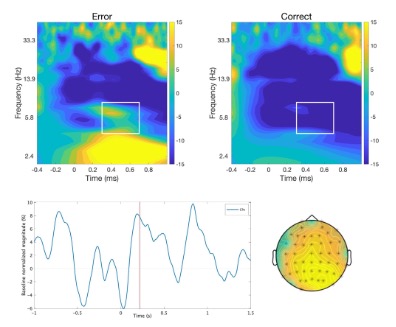Analisi Time-Frequency di dati EEG con Software Brainstorm/ Time-frequency analysis of EEG data with Brainstorm Software 2025
Finalità
Purpose
Negli ultimi anni si sente sempre più spesso parlare dello studio delle oscillazioni tramite elettroencefalografia (EEG), come la modulazione di onde alpha o theta, o l'entrainment in gamma. Le analisi che permettono di studiare come variano le frequenze nel tempo (ad esempio in risposta ad uno stimolo) sono generalmente chiamate analisi "Time Frequency". La popolarità di questa tipologia di analisi è legata alla capacità di integrare le informazioni fornite da analisi più tradizionali, come gli ERPs (potenziali evento-relati), analisi molto efficaci, che tuttavia non considerano parte delle informazioni fornite dal segnale. Lo scopo di questo corso è comprendere e utilizzare le principali analisi di Frequenza (es. PSD) e Tempo-Frequenza (es. Hilbert, Morlet). Utilizzeremo insieme un software gratuito (Brainstorm) con interfaccia grafica, largamente utilizzato per le analisi EEG. In base al tempo disponibile approfondiremo anche l'utilizzo degli scripts tramite Brainstorm.
In recent years we often hear about the study of oscillations using electroencephalography (EEG) as, for example, the modulation of alpha or theta waves, or gamma entrainment. The analyses that allow us to study how frequencies vary over time (e.g. in response to a stimulus) are generally called "Time-Frequency" analyses. The popularity of this type of analysis is linked to the ability to integrate the information obtained with more traditional analysis, such as the ERPs, a very effective strategy, which however do not consider part of the information of the signal. The purpose of this course is to understand and learn how to apply the main Frequency (e.g., PSD) and Time-Frequency (e.g., Hilbert, Morlet) analyses. We will use together a free software (Brainstorm) with a graphic interface, widely used for EEG analyses. Based on the time available, we will also deepen the use of scripts through Brainstorm.
Software utilizzato
Software used
Se utilizzate il vostro portatile personale, ai fini del corso è necessario scaricare due programmi, MATLAB e Brainstorm:
- MATLAB: si raccomanda di scaricare ed installare il programma prima dell'inizio del corso. Matlab si può scaricare gratuitamente tramite account Unipd (https://www.unipd.it/convenzioni-software). Durante l'installazione di Matlab, tra le opzioni, se possibile installare anche la Signal Processing Toolbox.
- Brainstorm: il software può essere scaricato gratuitamente collegandosi al seguente indirizzo https://neuroimage.usc.edu/bst/download.php, creando un account personale e scaricando il pacchetto chiamato "source+binary" sotto la voce "software". Seguire le istruzioni per l'installazione del software (https://neuroimage.usc.edu/brainstorm/Installation), altrimenti provvederemo a farlo assieme la prima giornata del corso (per l'installazione di Brainstorm è necessario prima aver installato Matlab). Per dubbi potete contattarmi a: fiorella.delpopolocristaldi@unipd.it
For the purpose of the course it is necessary to download two programs:
- Matlab: it is recommended to download the free software before the start of the course through a Unipd account (https://www.unipd.it/convenzioni-software). During the installation of Matlab, among the options, if possible also install the Signal Processing Toolbox.
- Brainstorm: can be installed for free, after installing MATLAB, by connecting to the following address https://neuroimage.usc.edu/bst/download.php, creating a personal account and downloading the package called "source + binary" under the heading "software". If possible, follow the instructions for installing the software (https://neuroimage.usc.edu/brainstorm/Installation), otherwise we will do it together on the first day of the course.
It is recommended to install MATLAB before the course starts. In addition, it is recommended that you download Brainstorm before the course. The Brainstorm installation procedure will be shown during the first lesson for those who have not yet installed it.
Programma del corso
Course program
L’obiettivo del corso è rendervi autonomi nella conduzione di analisi time-frequency su dati EEG relativi ad un compito sperimentale.
- Brainstorm: guida all’installazione del programma e panoramica generale del software e dell'interfaccia grafica
- Pre-preprocessing per ERPs e analisi Time Frequency: introduzione sulla natura del segnale EEG, pre-processing del segnale, ovvero i passaggi necessari per ottenere un ERP/Time-frequency; approfondimento sulla differenza tra questi due tipi di analisi
- Time-frequency: principali analisi, come ispezionare i risultati e come interpretare i grafici
- Disegno del task: quali accortezze adoperare quando si vuole fare un esperimento EEG con analisi time-frequency
- Pratica: la maggior parte del tempo verrà dedicato a sessioni pratiche, sia con interfaccia grafica che tramite codice (quest'ultimo a seconda del tempo disponibile), riprendendo i concetti trattati nelle sessioni teoriche
Prova finale:
Escuzione pratica di analisi time-frequency su dataset EEG.
The aim of the course is to make you independent in conducting time-frequency analysis of an experimental task.
- Brainstorm: installation guide and general overview of the software and analyses
- ERPs and Time Frequency analysis: brief introduction on the nature of the EEG signal, on the steps necessary to obtain the ERPs and Time-frequency plots, and the difference between these two types of analysis
- Time-frequency: application of different types of analyses, how to inspect the results and how to interpret the graphs
- Design of the task and importance of the baseline: what precautions to use when you want to do an EEG experiment with time-frequency analysis
- Practice: most of the time will be dedicated to practical sessions, both with graphic interface and through code (the latter depending on the time available), taking up the concepts covered in the theoretical sessions
Final test:
Practical execution of time-frequency analyses on an EEG dataset.

Prerequisiti/Prerequisites: È preferibile (ma non necessario) avere una conoscenza base del segnale EEG/It is preferable (but not necessary) to have a basic knowledge of the EEG signal
Durata del corso/Duration of the course: 20 ore/hours
Aule di svolgimento delle lezioni/Classrooms for lessons: Aula CARS (Piano Terra, Psico1)
Possibilità di erogare il corso in inglese/Possibility of delivering the course in English: Si/Yes
Numero massimo partecipanti/Maximum number of participants: 10
Conduttore/Conductor: Fiorella Del Popolo Cristaldi




